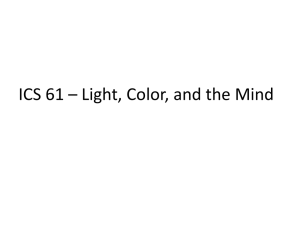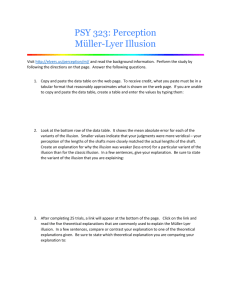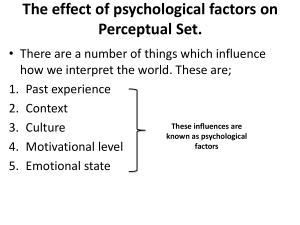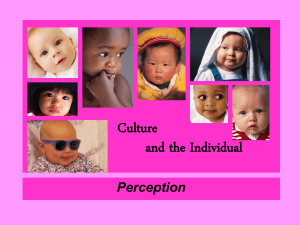presentations\MonaChapter 2
advertisement
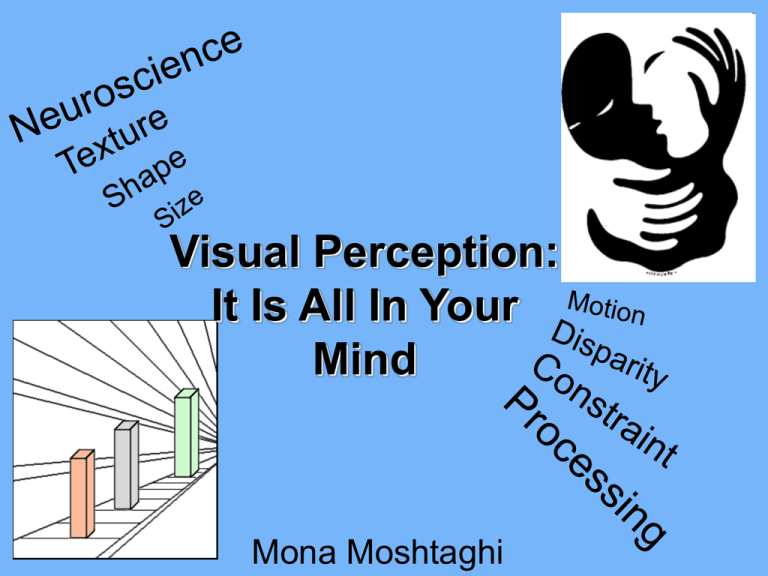
Visual Perception: It Is All In Your Mind Mona Moshtaghi http://homepage.psy.utexas.edu/homepage/class/Psy308/Salinas/Vision/Vision.html Beginnings of Human Perception • Perception of a real object is based on “sensory data representing the physical properties of the object such as its weight, reflectance, rigidity, stiffness and texture.” • Plato – “Platonic Solids” • Aristotle – “There is nothing in the mind that was not first in the senses.” • David Marr – Vision http://ucelinks.cdlib.org:8888/sfx_local?sid=Entrez:PubMed&id=pmid:19800910 James J. Gibson • Psychologist in the field of visual perception • Introduced texture gradient ____________________________________________ • Visual texture cue to the 3D structure of surfaces • Texture studied as 3D cue (computational and computer vision) http://www.journalofvision.org/content/6/9/3.long Decompositions of Texture Gradients Into Different Components http://www.journalofvision.org/content/6/9/3.long David Marr Three Levels of Understanding Complex Information-Processing Devices Computational Approach Most abstract level Describes the problem the system is trying to solve & the constraints it uses in order to solve it Representation and Algorithmic Addresses the questions of representations Hardware Implementation Involves the details of the hardware in which the algorithm is embodied http://www.cs.huji.ac.il/~yweiss/intro/node2.html Marr’s “2.5D Sketch” • • • • Opaque cube 7 of the 8 vertices 9 of the 12 edges More than half of the 3D shape can be seen when represented by contours or vertices http://ucelinks.cdlib.org:8888/sfx_local?sid=Entrez:PubMed&id=pmid:19800910 Computational Geometry • Vertices: 0-dimensional cells • Edges: 1-dimensional cells • Regions or Faces: 2-dimensional cells http://graphics.stanford.edu/courses/cs268-09-winter/ http://illusion.scene360.com/3d/5105/computational-geometry/ A, B: In the Ponzo illusion, the two converging lines provided the depth impression that the two physically identical objects were located at different distances from the observer, and the distant object looks larger than the object that appears closer in space. C: In the Ebbinghaus illusion, the object surrounded by small items looks larger than a physically identical object surrounded by big items. http://www.ncbi.nlm.nih.gov/pmc/articles/PMC3062603/figure/F1/ Art & Perspective Cayetano Ferrer http://illusion.scene360.com/art/13257/invisible-mail-packages-street-sign-and-billboard/ Mary Temple Latex paint on walls Illusion of light coming from a window into a room Research continues… How does the brain accomplish diverse functions of scene understanding? Where What http://homepage.psy.utexas.edu/homepage/class/Psy308/Salinas/Vision/Vision.html Disentangling scene content from spatial boundary: complementary roles for the parahippocampal place area and lateral occipital complex in representing real-world scenes. •Analysis of the visual scene account for the objects and the spatial layout of surfaces in a scene • Parahippocampal place area (PPA) same spatial boundaries • Lateral occipital complex (LOC) same content http://www.ncbi.nlm.nih.gov/pubmed/21273418 New approach to the perception of 3D shape based on veridicality, complexity, symmetry and volume. • 3D shape is unique in perception – Complexity identification of objects • 3D shape perception is veridical (car, chair, etc) http://www.ncbi.nlm.nih.gov/pubmed/19800910 Hide & Seek That Beer… Thank You

